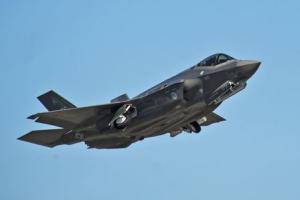WASHINGTON (Reuters) - The U.S. military has ordered mandatory inspections of all Lockheed Martin Corp F-35 fighter jets before further flights after a Marine Corps F-35B model suffered an in-flight emergency last week, a Pentagon spokesman said on Sunday.
Joe DellaVedova, spokesman for the F-35 program office, said the inspections were ordered late on Friday but that a majority of the 97 F-35s in the fleet - 69 operational jets used for training and 28 test aircraft - had already been inspected and cleared to resume flights on Monday.
He said the inspections, first reported by the Wall Street Journal, were focused on the oil flow management valve fitting on all F135 engines, which are built by Pratt & Whitney, a unit of United Technologies Corp. The valve provides oil flow to the engine bearing compartments.
News of the engine issue came just days after Frank Kendall, the Pentagon's chief arms buyer, said the F-35 program was making progress but more work was needed on developing the jet's software and improving its reliability.
The inspections were ordered after an F-35B model suffered an in-flight emergency on June 10 caused by oil loss in the jet's engine at a Marine Corps base in Yuma, Arizona, where issues have now been found with a total of three valves, DellaVedova said.
He said the pilot returned to base safely and there were no injuries.
No issues have been discovered at the other bases where F-35s are flown in California, Florida, Arizona and Maryland, he said.
Pratt & Whitney spokesman Matthew Bates said the company was working closely with the Pentagon's F-35 program office to determine the cause of the issue. He said it took about 90 minutes to inspect each aircraft, and nearly all planes had been inspected and cleared for further flights.
Bates said the F135 engine had completed nearly 32,000 hours of combined ground and flight testing, with more than 16,000 logged in operational flights. Engine availability had remained steady at or above 98 percent, he said.
Bates also said the engine was designed to survive significant damage from foreign objects as well as oil deprivation, and the control system for the engine included redundant mechanical and electronic parts.
DellaVedova said the source of that F135 engine oil leak appeared to be a supply line to engine bearings and a fitting that separated from the body of the valve in question.
It was not clear if the issue was maintenance-related. LINK



